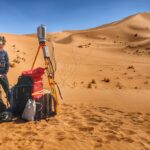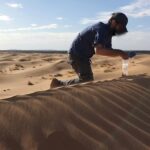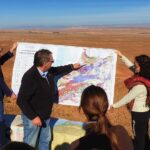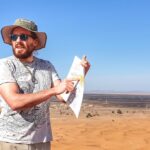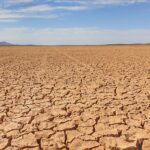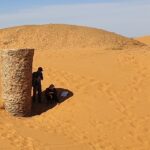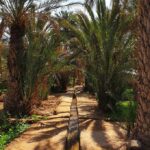This week, the research groups Geomorphology and 3DGeo of the Institute of Geography at Heidelberg University are conducting a field course in the aeolian sand dune field Erg Chebbi in Morocco. The current field course is the second edition of “HeidelErg“.
The aim is to teach students different methods of data acquisition for physical geography, on the one hand, and to collect data for the analysis of surface and subsurface characteristics of star dunes, on the other hand. Various techniques from geophysics to 3D geodata acquisition are deployed in the frame of this field course: Sediment analysis, electrical resistivity tomography (ERT), ground penetrating radar (GPR), global navigation satellite system (GNSS) measurements, and terrestrial laserscanning. Some field days are still required to complete the multi-source dataset and report about first analyses. For now, we can give a first impression what our daily work in the sand looks like – with more to follow.
Before starting the field work, the group explored some interesting sites in the region around Erg Chebbi to get to know the stunning landscape elements of this hyper-arid region. This small excursion cannot be enough to understand the complex geomorphology and geology of Morocco – but we certainly learnt a lot from Manuel Herzog and Prof. Olaf Bubenzer, who explained the basics and latest insights along the way.
Until our next blog post, check out our occasional updates on Twitter: #HeidelErg
Interested to read more about research on star dunes? Continue here:
Herzog, M., Anders, K., Höfle, B., Bubenzer, O. (2019): Multi-method investigation of star dunes in Morocco (Erg Chebbi):topography, stratigraphy and implications for OSL-sampling. Geophysical Research Abstracts, 21, EGU2019-6950.
Herzog, M., Kanig, M., Bubenzer, O. (2019): Electrical resistivity tomography and forward modelling in hyper-arid environments – A case study from Erg Chebbi, Southeast Morocco. Zeitschrift für Geomorphologie Supplementary Issue 62 (1), 119-135. DOI: 10.1127/zfg_suppl/2019/0529.



